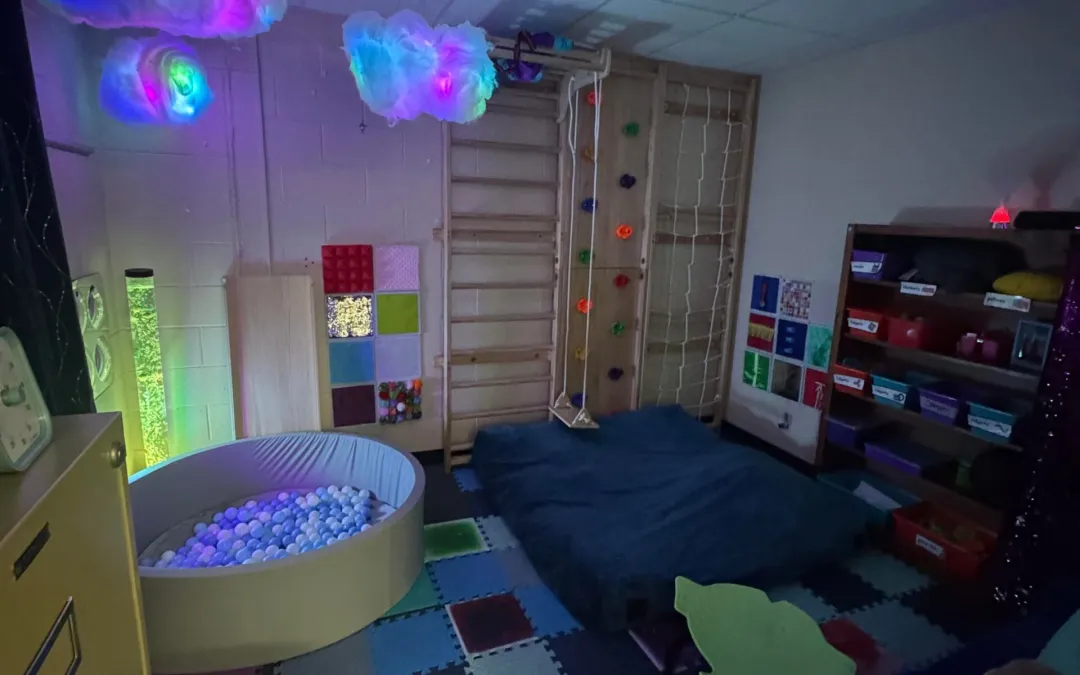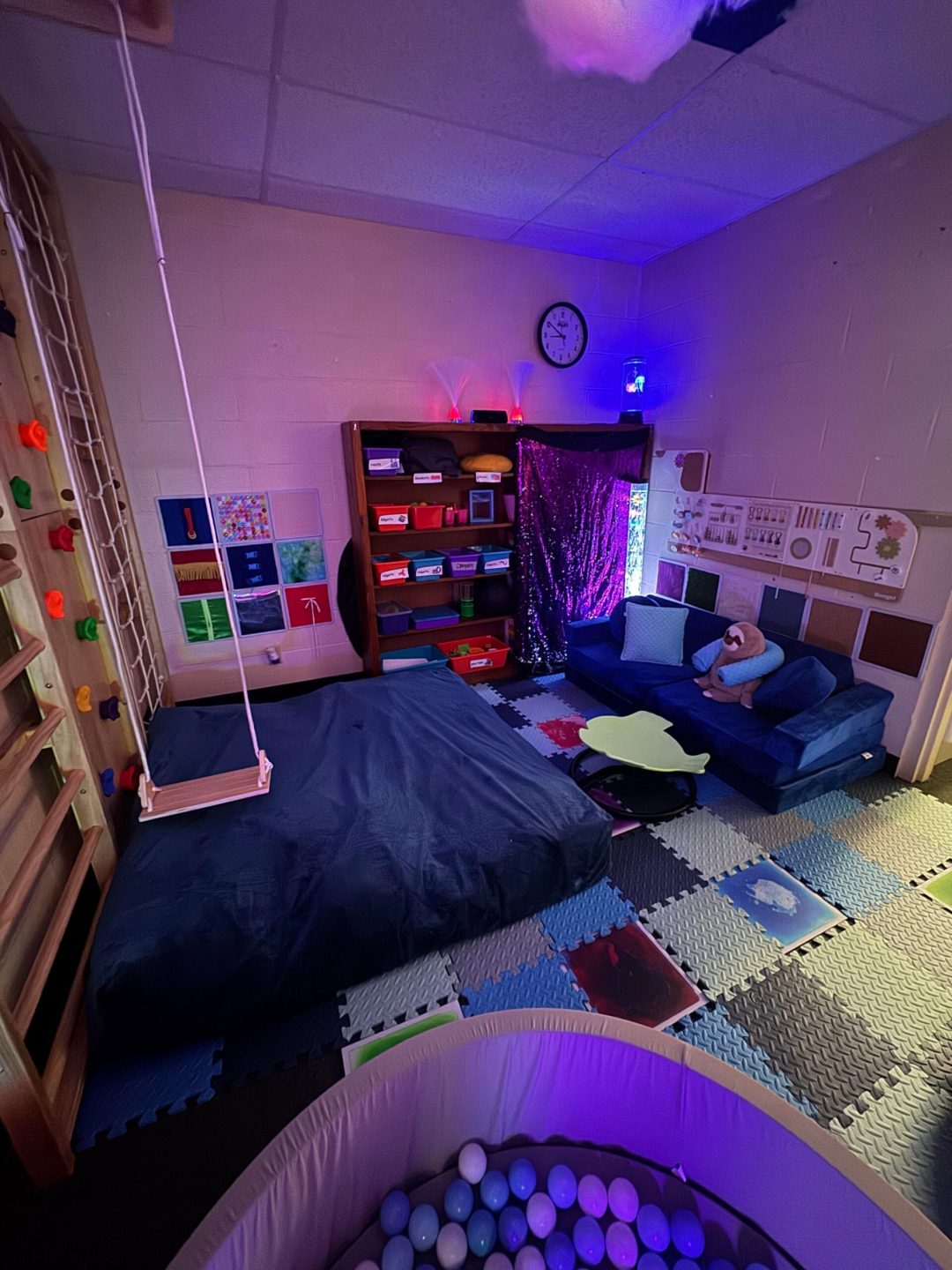From Storage Closet to Sanctuary: How One Teacher Transformed a Room—and Lives—at Park Elementary
With a grant from the Community Foundation of Southeast Kansas, special education teacher Rylee Crain transformed an unused office at Park Elementary in Columbus into a sensory room. This new space provides all students with essential tools for emotional regulation, leading to a significant decrease in behavioral issues and an increase in their readiness to learn.


By Amy Howe
At first glance, the unused office in Rylee Crain’s special education classroom at Park Elementary in Columbus, Kansas, looked like nothing more than a makeshift storage closet—crammed with extra supplies and a few underutilized sensory tools. But to Crain, it looked like opportunity.
“I saw firsthand how many students were struggling to regulate their emotions throughout the day,” she said. “They needed a safe, calming environment where they could reset and return to class ready to learn. That little room had the potential to become something meaningful.”
Crain, a special education teacher at Park Elementary, brought the idea of converting the space into a sensory room to her principal, who encouraged her to pursue the vision and apply for grant funding. The school’s limited resources wouldn’t cover the project, and without financial help, the transformation simply wouldn’t be possible, at least not in time for the next school year.
That’s when Crain discovered the Community Foundation of Southeast Kansas (CFSEK) and its General Funds grant cycle, which focuses on initiatives like youth activities, education and wellness. Her application outlined a plan for a sensory room accessible to all students—a place not just for breaks, but for building better regulation, relationships and readiness to learn.
To her delight, the project was funded.

Meeting a Growing Need
The idea wasn’t born out of thin air. Over the past year, Crain and the school’s resource team noticed a rising trend in students struggling with emotional regulation, focus and sensory processing. Transitions such as coming in from recess or moving between classes often triggered behavioral outbursts or led to academic avoidance. The old “quiet room” offered a plain space for cooling off, but it lacked the tools or structure students needed to truly re-regulate.
“We were frequently removing students from class to give them sensory breaks, but we didn’t have a consistent or well-equipped space for that,” Crain explained. “The data from behavior charts and referrals made it clear—we needed something better.”
What they needed was a designated space tailored to calming the nervous system, offering sensory input or output depending on what the student needed. Crain’s grant-funded solution delivered exactly that.
A Room with a Purpose
The finished sensory room is now a warm, inviting space designed to meet diverse student needs through movement, calming activities and tactile stimulation. Some of the standout features include a custom indoor playground with a swing, rock wall, detachable slide and rope wall—elements that provide both proprioceptive and vestibular input essential to self-regulation. The room also features a ball pit, calming fish tube, sensory wall panels, soft lighting, lavender scents, noise-canceling headphones, liquid sensory floor tiles, weighted vests and blankets, and various fidgets and tactile tools.
“The room is cozy, colorful and calming all at once,” Crain said. “And it was only possible because of the grant funding.”
But the impact goes far beyond the décor. Since opening the sensory room, Crain and her colleagues have noticed a remarkable shift in student behavior and academics.
“Students are now more independent and self-aware,” she said. “They’re learning to recognize when their bodies need movement, quiet or sensory input—and they know where to go to get it.”
Teachers across the building have seen the difference, too. In fact, the room has become a shared resource—open to every student and used by nearly every teacher at Park Elementary.
“It’s helped students regulate without disrupting their entire day,” Crain noted. “And it’s helped teachers manage their classrooms more effectively.”
One Student’s Journey
Among the many success stories, one stands out in Crain’s memory—a young boy who, early in the year, was spending more time outside the classroom than in it.
“He was missing academic lessons and struggling to build relationships with his peers because of frequent dysregulation,” she said. “At first, we built in scheduled sensory breaks for him, and immediately we saw a shift.”
Over time, the student began to self-advocate for breaks and use the room intentionally. His behavior incidents declined, his academic participation increased, and most importantly, he developed the self-awareness and skills needed to succeed socially and academically.
“By the end of the year, he hardly needed the room at all,” Crain said. “He had grown so much. Seeing that transformation is the most rewarding part of my job.”
A New Lens for Teaching
The project not only changed the lives of students—it reshaped Crain’s own approach to teaching. Prior to the project, she admits her understanding of sensory processing was limited.
“I knew some kids needed movement or calming breaks, but I didn’t fully understand why,” she said. “This project pushed me to do research, attend trainings and work closely with our occupational therapist.”
That learning curve has led to deeper connections with her students, and a better ability to meet their individual needs.
“I’m still learning, and always will be,” Crain added. “But now I’m better equipped to identify what supports students need and how to proactively implement them.”
Lasting Impact, Future Plans
While Crain will be moving to a new building next school year, the lessons and inspiration she gained through the sensory room project are coming with her.
“I won’t be teaching SPED next year, but I’ve already started planning to replicate the sensory room in my new school,” she said. “The results speak for themselves.”
She hopes the success at Park Elementary inspires other educators to look around their own schools, spot an unused space or unmet need and take action.
“My parents always told me I could make anything happen if I just believed in myself and tried,” Crain said. “The worst that can happen is someone says no. The best? You change lives.”
Grant Funding That Makes a Difference
None of this would have been possible without the support of the Community Foundation of Southeast Kansas. Crain is adamant about that.
“We had the dream and the need, but we didn’t have the funds,” she said. “The grant gave us the ability to move quickly and make this happen for our students when they needed it most.”
It’s not just a sensory room—it’s a sanctuary, a support system and a symbol of what happens when educators are empowered and communities invest in their youth.
Crain encourages other teachers with big ideas to seek out similar opportunities. “There are organizations out there that want to support schools. If you see a need—go for it.”
Because sometimes, the smallest room in the building can become the most powerful.






